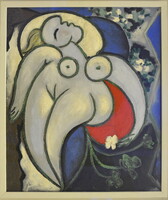| dc.coverage.spatial | Site: Centre Georges Pompidou (Paris, Île-de-France, France) AM 1984-631 | en_US |
| dc.coverage.temporal | June 19, 1932 (design) | en_US |
| dc.creator | Picasso, Pablo | en_US |
| dc.date.accessioned | 2016-08-23T18:13:37Z | |
| dc.date.available | 2016-08-23T18:13:37Z | |
| dc.date.issued | 1932 | |
| dc.identifier | 267967 | en_US |
| dc.identifier.other | archrefid: 3326 | en_US |
| dc.identifier.uri | http://hdl.handle.net/1721.3/184281 | |
| dc.description | Overall view; 1932 marked a turning point in Picasso's life with Marie-Thérèse Walter; for it was at this time that they began to escape the secrecy and subterfuge of their affair, and replaced it with the tranquillity of Boisgeloup, the château which Picasso bought to use as a hideaway for this intense romance. It was a place where they could leave their worries and Picasso's wife Olga behind them. In Boisgeloup, Picasso and Marie-Thérèse lived a relaxed home life together. The majority of Picasso's Boisgeloup paintings show Marie-Thérèse absorbed in a blissful sleep, as here. Source: Christie's; http://www.christies.com/ (accessed 7/14/2015) | en_US |
| dc.format.medium | oil paint on canvas | en_US |
| dc.rights | © Scott Gilchrist, Archivision, Inc. | en_US |
| dc.subject | abstraction | en_US |
| dc.subject | human figure | en_US |
| dc.subject | nude in art | en_US |
| dc.subject | Twentieth century | en_US |
| dc.subject | Modernist | en_US |
| dc.title | Woman reclining | en_US |
| dc.title.alternative | Femme couchée | en_US |
| dc.type | image | en_US |
| dc.rights.access | Licensed for educational and research use by the MIT community only | en_US |
| dc.identifier.vendorcode | 7A1-PICASSO-FC-A01 | en_US |
| vra.culturalContext | French | en_US |
| vra.technique | oil painting (technique) | en_US |
| vra.worktype | painting (visual work) | en_US |
| dc.contributor.display | Pablo Picasso (Spanish painter, 1881-1973) | en_US |

